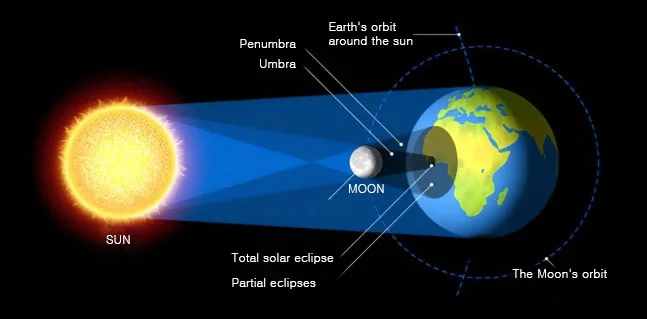Table of Contents
Solar Eclipse 2024

A total solar eclipse 2024 is scheduled to occur on April 8, 2024, encompassing the entirety of the North American continent. This infrequent astronomical occurrence, characterized by the moon’s precise alignment with the Earth and the sun, will result in a shadow being thrown over some regions of Mexico, the United States, and Canada, causing a temporary transition from day to night, evoking a sense of amazement and wonder. These occurrences have consistently fascinated the human population, providing a distinctive insight into the mechanisms of our solar system and the intricate equilibrium it maintains.
The eclipse will start its trajectory at the Pacific Coast of Mexico, signifying the initiation of an extraordinary trajectory that will traverse many states inside the United States prior to culminating in Canada. In this trajectory, anybody situated inside the limited range of totality would encounter absolute absence of light, as the moon obstructs the sun, therefore unveiling the sun’s celestial halo. Beyond this trajectory, a partial eclipse will be perceptible to a far larger audience, so presenting a broad-ranging prospect for astronomical observation and public involvement.
The purpose of this introduction is to present a comprehensive outline of the 2024 total solar eclipse, emphasizing its trajectory in North America, the importance of this occurrence, and the awe it evokes in observers. As the approaching day approaches, there is an increasing sense of anticipation, not just among enthusiastic astronomers and scientists, but also among communities around the continent, all ready to participate in this collective cosmic event.
Area and Time of Eclipse Observation
The complete solar eclipse of 2024 presents a distinctive phenomenon as it cover a substantial expanse of the North American continent. Individuals situated along the trajectory of totality will be afforded the comprehensive encounter of the eclipse, whereby the moon fully envelops the sun, resulting in a transient interval of diurnal darkness and unveiling the sun’s corona. This document provides a comprehensive description of the geographical and temporal aspects of the eclipse observation, elucidating its trajectory throughout Mexico, the United States, and Canada.
The starting area for the eclipse observation is Mexico. The Pacific Coast
At precisely 11:07 AM local time, the eclipse will begin on the Pacific Coast of Mexico. Upon the descent of the moon’s shadow, those residing in this particular area will be the first to encounter the commencement of completeness. This first location signifies the commencement of an exceptional expedition spanning the entire continent.
The cities and times that are accessible inside the United States.
As the eclipse progresses in a northerly direction, it will traverse the United States, intersecting many cities along its trajectory. The primary geographical points and their respective local moments of totality encompass:
– **Dallas, Texas**: The eclipse is anticipated to take place in the early afternoon, offering a remarkable spectacle for individuals assembled in open areas and parks.
– **Little Rock, Arkansas**: The eclipse will traverse the mid-afternoon sky, providing unobstructed visibility for individuals situated far from towering structures and urban illumination.
Carbondale, Illinois, a place renowned for its past occurrences of eclipses, will once again serve as a prominent location for early afternoon observation.
The cities of Cleveland, Ohio, Buffalo, New York, and Caribou, Maine will encounter the eclipse around the mid to late afternoon, respectively. These locations provide distinct perspectives for observing this celestial phenomenon.
The trajectory and culmination of the eclipse in Canada.
The eclipse will proceed along its trajectory, traversing Canada from southern Ontario to the Atlantic coast of Newfoundland. This signifies the final phase of the eclipse’s observable trajectory in North America. Individuals in these areas will observe the eclipse in the late afternoon and early evening, which will serve as a magnificent conclusion to the day’s celestial display.
Recommendations for Viewing
For individuals situated inside the trajectory of totality, the eclipse offers a unique occasion to witness the transition from day to night and watch the corona of the sun, a phenomenon that is not perceptible during typical daylight periods. Viewers are advised to choose a pristine, unobstructed vantage point of the sky and make necessary arrangements for the abrupt decrease in temperature that accompanies the entirety of the celestial display.
Even when a partial eclipse occurs beyond the path of totality, it still presents a visually striking spectacle. It is recommended that those in these regions utilize appropriate sun viewing glasses in order to properly partake in the event.
The 2024 total solar eclipse is an essential astronomical event that provides North American watchers with an opportunity to witness a magnificent natural display that brings the continent together in awe and observation.
Points of Astronomical Observation
The 2024 complete solar eclipse offers a remarkable visual spectacle and a distinctive chance for astronomical observation. In addition to the remarkable phenomenon of totality, this eclipse provides an opportunity to observe celestial entities that are often concealed by the intense luminosity emitted by the sun. During the event, Venus and Jupiter are expected to assume significant roles, providing a visually captivating spectacle for onlookers.
Venus and Jupiter Observation
During a complete solar eclipse, the celestial sphere will see a significant reduction in brightness, therefore exposing Venus and Jupiter, which are among the most prominent celestial bodies in our sky, after the Sun and Moon. These celestial bodies will become perceptible to the unaided human eye, an uncommon occurrence during the daytime.
Venus is commonly known as the “Evening Star” or the “Morning Star” because to its luminous and enduring nature. Venus will be observable to the west of the Sun during the eclipse. Observers should search for a luminous and unwavering light in the sky, which will be noticeable even prior to the commencement of totality in certain areas.
- Conversely, Jupiter will be positioned to the east of the Sun. Jupiter, renowned for its substantial dimensions and luminous manifestation, will be identifiable by its consistent and intense luminosity in contrast to the gloomy expanse of the sky.
The observations of these planets provide a distinctive teaching opportunity, showcasing the intricate workings of our solar system and the relative spatial arrangement of its celestial entities.
The significance of astronomical research in relation to the Solar Corona
A complete solar eclipse offers a unique chance to directly observe the Sun’s corona, the outer layer of the Sun’s atmosphere that is often obscured by the intense brightness of the solar disk. This event holds great significance for both professional astronomers and amateur skywatchers due to the fact that the corona can only be observed from Earth during a total solar eclipse.
The examination of the solar corona has significant importance for several reasons:
- Research Significance: The study of the corona has significant importance in comprehending solar events, including solar flares and coronal mass ejections. Scientists may collect data on the temperature, composition, and dynamics of an eclipse by making observations during it.
- Educational Prospect: The eclipse presents a valuable educational opportunity for individuals, providing them with a personal experience in the field of solar astronomy. It has the potential to ignite curiosity in the fields of science and astronomy among individuals of all age groups, offering a remarkable encounter that showcases the marvels of the cosmos.
Tips for Observing the Celestial Bodies of Venus and Jupiter
In order to optimize the utilization of this astronomical phenomenon, it is advisable for spectators to engage in proactive planning. Ascertain the orientation of Venus and Jupiter with respect to the trajectory of the eclipse to guarantee an unobstructed line of sight.
The utilization of astronomy applications can enhance the viewing experience by facilitating the identification of Venus and Jupiter in the celestial sphere.
Prioritising Safety: Ensure to utilize eclipse glasses when observing Venus and Jupiter in close proximity to the sun, particularly before to and following totality.
By incorporating Venus and Jupiter into the eclipse, this astronomical event becomes more intricate, providing a wider outlook on the workings of our solar system and the splendor of celestial occurrences.
Discover More
If this article made you happy and taught you something, I’m sure our next article will do the same for you. Each piece is carefully written to help you understand things better and enjoy reading more. So, to keep exploring and having fun, just click on this link to go to our next story.
How Does Your Choice Between Draft and Canned Beer? – ReViewMaster DEN (rvmden.com)



